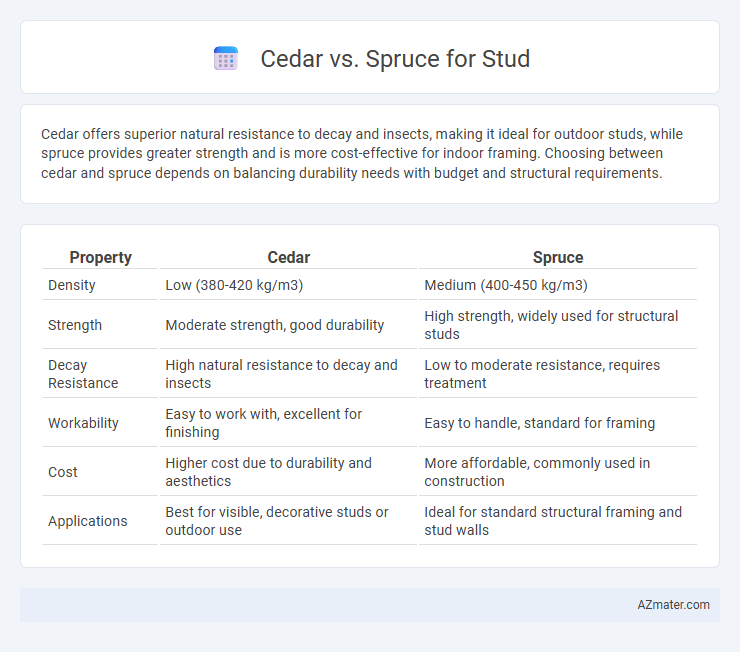Cedar offers superior natural resistance to decay and insects, making it ideal for outdoor studs, while spruce provides greater strength and is more cost-effective for indoor framing. Choosing between cedar and spruce depends on balancing durability needs with budget and structural requirements.
Table of Comparison
| Property | Cedar | Spruce |
|---|---|---|
| Density | Low (380-420 kg/m3) | Medium (400-450 kg/m3) |
| Strength | Moderate strength, good durability | High strength, widely used for structural studs |
| Decay Resistance | High natural resistance to decay and insects | Low to moderate resistance, requires treatment |
| Workability | Easy to work with, excellent for finishing | Easy to handle, standard for framing |
| Cost | Higher cost due to durability and aesthetics | More affordable, commonly used in construction |
| Applications | Best for visible, decorative studs or outdoor use | Ideal for standard structural framing and stud walls |
Introduction to Cedar and Spruce as Stud Materials
Cedar and spruce are popular choices for stud materials in construction due to their distinct properties and availability. Cedar offers natural resistance to decay and insects, making it suitable for environments prone to moisture, while spruce is favored for its strength-to-weight ratio and affordability. Understanding the differences in durability, weight, and cost between cedar and spruce is essential for selecting the right stud material for framing projects.
Physical Properties Comparison
Cedar studs feature a lower density of approximately 23 pounds per cubic foot, providing excellent natural resistance to decay and insect damage, making them ideal for structural durability in moist environments. Spruce studs, with a higher density near 28 pounds per cubic foot, offer superior strength and stiffness, contributing to better load-bearing capacity in framing applications. The dimensional stability of cedar helps reduce warping and swelling, whereas spruce tends to maintain consistent straightness and is often favored for its uniform grain and ease of nailing.
Durability and Longevity
Cedar studs offer superior durability and natural resistance to rot, decay, and insect damage, making them ideal for long-lasting structural applications. Spruce studs, while generally more affordable and widely available, have less natural durability and may require chemical treatment to achieve similar protection against environmental factors. Choosing cedar for studs ensures enhanced longevity and reduced maintenance in construction projects.
Resistance to Decay and Insects
Cedar wood exhibits superior resistance to decay and insect damage compared to spruce, largely due to its natural oils and dense grain structure that inhibit fungal growth and repel insects. Spruce, while commonly used in construction, lacks these protective compounds, making it more susceptible to rot and insect infestation over time. Choosing cedar for studs enhances the longevity and durability of structural framing in environments prone to moisture and pests.
Weight and Workability
Cedar is significantly lighter than spruce, making it easier to handle and transport for stud framing. Spruce offers superior workability due to its uniform grain and higher stiffness, which provides better nail and screw holding strength. The lightweight nature of cedar reduces fatigue during installation, but spruce's balance of strength and workability makes it a preferred choice for structural studs.
Cost and Availability
Spruce is generally more cost-effective and widely available than cedar for stud framing, making it the preferred choice in budget-conscious construction projects. Cedar, while pricier due to its natural resistance to decay and insects, offers durability and aesthetic appeal but can be harder to source in larger quantities. Builders often select spruce for its consistent supply and lower upfront costs, especially in regions where spruce forests are abundant.
Environmental Impact and Sustainability
Cedar studs exhibit a lower environmental impact due to the wood's natural resistance to decay and insects, reducing the need for chemical treatments and prolonging material lifespan. Spruce, often sourced from fast-growing plantations, supports sustainable forestry practices by enabling rapid regeneration and carbon sequestration. Both woods contribute to carbon storage, but cedar's durability enhances long-term sustainability in construction applications.
Insulation and Acoustic Performance
Cedar studs provide superior insulation due to their natural thermal resistance, reducing heat transfer and improving energy efficiency in building walls. Spruce studs, while commonly used for framing, offer lower insulation values but possess good acoustic performance by dampening sound transmission through wall assemblies. Choosing cedar for studs enhances both thermal insulation and soundproofing, making it ideal for energy-efficient and quieter indoor environments.
Common Applications in Construction
Spruce is widely used for framing and studs in construction due to its strength, lightweight properties, and cost-effectiveness, making it ideal for load-bearing walls and structural supports. Cedar is less common for studs but preferred in areas requiring natural resistance to moisture and decay, such as exterior walls, due to its durability and insect-repellent qualities. Builders often choose spruce for general interior framing and cedar for specialized applications where longevity and environmental exposure are critical.
Choosing the Right Stud: Cedar or Spruce?
Cedar studs offer superior natural resistance to moisture, decay, and insect damage, making them ideal for humid or outdoor environments. Spruce studs, on the other hand, provide higher strength-to-weight ratios and consistency at a lower cost, which suits indoor framing projects where load-bearing capacity is critical. Selecting between cedar and spruce studs depends on balancing durability needs with budget constraints and structural requirements.

Infographic: Cedar vs Spruce for Stud
 azmater.com
azmater.com